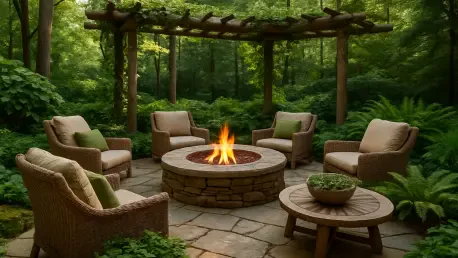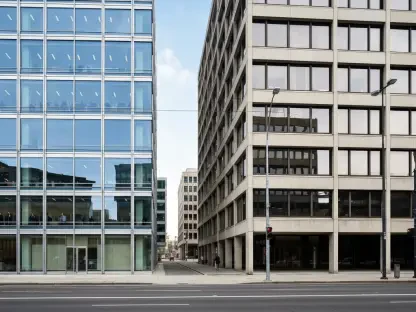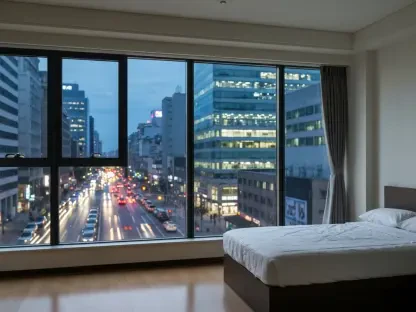In a world where home has become the ultimate sanctuary, outdoor living spaces are emerging as vital extensions of interior environments, seamlessly blending comfort with the allure of the natural world. Homeowners are increasingly choosing to enhance their properties rather than relocate, a decision fueled by escalating housing costs and a deeper yearning for personalized, meaningful spaces. Industry insights reveal that these outdoor areas are no longer mere afterthoughts but are being transformed into purposeful havens that elevate both lifestyle and property value. With a focus on integrating nature into design, the latest trends emphasize creating environments that resonate emotionally and functionally. Experts in the field are guiding this shift, advocating for cohesive, innovative approaches that prioritize aesthetics, safety, and sustainability. This exploration delves into the key movements shaping outdoor spaces, offering a glimpse into how nature-inspired concepts are redefining the way homes connect with their surroundings.
Connecting with Nature Through Biophilic Principles
Biophilic design stands at the forefront of transforming outdoor spaces into immersive, nature-connected retreats. This philosophy revolves around fostering a profound bond with the environment by incorporating elements that evoke natural serenity, such as expansive views, sheltered corners, and the gentle presence of water features. Homeowners are drawn to landscapes that mirror the calming essence of the outdoors, where lush greenery and thoughtful layouts create a sense of escape right at their doorstep. The aim is to dissolve the barriers between indoor and outdoor realms, allowing spaces to flow effortlessly and provide a daily dose of tranquility. By prioritizing these principles, outdoor areas become more than just functional; they turn into restorative sanctuaries that nurture well-being and enhance the overall living experience with a deep-rooted connection to the earth.
Beyond the visual appeal, biophilic design also focuses on engaging all the senses to enrich the outdoor experience. Imagine the sound of trickling water from a small fountain blending with the rustle of leaves, or the tactile pleasure of natural stone underfoot paired with the scent of blooming plants. These sensory elements are carefully curated to evoke emotional responses, making every moment spent outside feel rejuvenating. This approach also considers the practical integration of natural light and shade, ensuring spaces remain comfortable across seasons while maintaining an organic aesthetic. As a result, yards and patios evolve into dynamic environments that adapt to both environmental conditions and personal needs. This trend underscores a growing recognition of nature’s role in mental and physical health, encouraging designs that prioritize harmony over mere decoration, ultimately redefining how outdoor spaces contribute to a balanced lifestyle.
Blending Aesthetics and Safety with Unified Systems
The evolution of outdoor design has ushered in an era where decking and railing systems are no longer isolated features but integral components of a cohesive vision. Homeowners now seek solutions that marry visual elegance with uncompromising safety, ensuring that every element works in tandem to create a polished, secure environment. Modern innovations, such as sturdy aluminum railings and glass panels, provide protection without obstructing scenic views, while advanced composite decking materials resist heat to safeguard families and pets from discomfort. This shift toward integrated systems reflects a broader desire for spaces that are as safe as they are stunning, offering peace of mind alongside a refined look that complements the surrounding landscape.
Taking this integration a step further, the focus on unified systems also streamlines the planning and installation process for lasting results. By selecting materials and designs that align from the outset, the risk of mismatched components or functional oversights is minimized, resulting in a seamless finish that enhances both curb appeal and usability. For instance, railings are now designed not just as barriers but as stylistic statements that tie into the overall theme of the outdoor space, whether through sleek lines or natural tones. Meanwhile, decking innovations address practical concerns like durability and maintenance, ensuring surfaces withstand the elements without losing their charm. This holistic approach empowers homeowners to invest in spaces that deliver long-term value, balancing the dual demands of safety standards and aesthetic aspirations with finesse, while setting a new benchmark for thoughtful outdoor design.
Personalizing Spaces with Custom, Low-Maintenance Options
Customization has become a cornerstone of modern outdoor design, allowing homeowners to infuse their unique style into every detail of their exterior spaces. From composite decking with realistic woodgrain textures to railings in bold, on-trend hues like architectural black, the options for personalization are vast and versatile. These choices enable the creation of environments that reflect individual tastes while echoing the organic beauty of nature, all without the burden of high upkeep. The appeal lies in achieving a bespoke look—think warm, timber-like surfaces or sleek, modern lines—that feels distinctly personal yet remains practical for busy lifestyles, ensuring outdoor areas are both inviting and easy to care for over time.
Equally important in this trend is the emphasis on low-maintenance materials that stand up to wear and weather without sacrificing style. Advances in technology have made it possible to enjoy the rustic charm of natural finishes through composites that resist fading, warping, or cracking, eliminating the need for frequent staining or sealing. Similarly, railings crafted from durable metals or innovative blends offer longevity and safety while maintaining a clean, tailored appearance with minimal effort. This combination of customization and convenience caters to a growing demand for sustainable solutions that prioritize both environmental impact and personal expression. As a result, outdoor spaces become enduring reflections of homeowner identity, crafted to inspire and endure with minimal intervention, aligning perfectly with contemporary values of efficiency and individuality.
Enhancing Functionality with Thoughtful Design Accents
Outdoor areas are increasingly being reimagined as distinct, purposeful “rooms” through the strategic use of design accents that add both character and utility. Features like pergolas provide shaded retreats for relaxation, while built-in planters bring bursts of greenery that soften hardscapes and foster a natural ambiance. Decorative screens offer privacy without feeling closed off, and integrated lighting extends the usability of spaces into the evening hours with a warm, welcoming glow. These elements work together to define specific zones within a yard or patio, transforming open areas into intentional settings for dining, lounging, or entertaining, all while enhancing the connection to the surrounding environment.
Delving deeper into this trend, the incorporation of railings with artistic infill panels or complementary design touches ties these accents into a unified aesthetic that resonates throughout the landscape. Such details elevate the sense of craftsmanship, making each space feel deliberately curated rather than haphazardly assembled. The addition of lighting, for instance, not only serves a practical purpose but also highlights architectural features or plantings, creating depth and drama after dark. Meanwhile, structures like pergolas can be customized to support climbing vines, further blurring the line between built and natural elements. This thoughtful layering of features ensures that outdoor spaces are not just functional but also emotionally engaging, offering a canvas for creativity that adapts to evolving needs and preferences, ultimately redefining how these areas contribute to daily life.
Reflecting on Nature’s Role in Home Design
Looking back, the journey of outdoor living spaces reveals a profound shift in how homeowners and industry experts alike embrace nature as a core pillar of home enhancement. The adoption of biophilic principles has reshaped yards and patios into sanctuaries that nurture both body and mind, while unified systems ensure safety never compromises beauty. Customization through innovative, low-maintenance materials allows personal expression to flourish, and design accents carve out purposeful zones within open landscapes. Moving forward, the challenge lies in sustaining this momentum by exploring new materials and technologies that further harmonize built environments with the natural world. Industry professionals are encouraged to continue advocating for integrated planning and phased approaches, ensuring spaces evolve alongside homeowner needs. As this transformative era in outdoor design unfolds, the enduring lesson remains clear: investing in nature-inspired solutions not only elevates properties but also enriches lives with lasting, meaningful connections to the outdoors.









